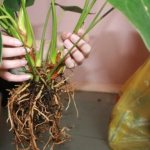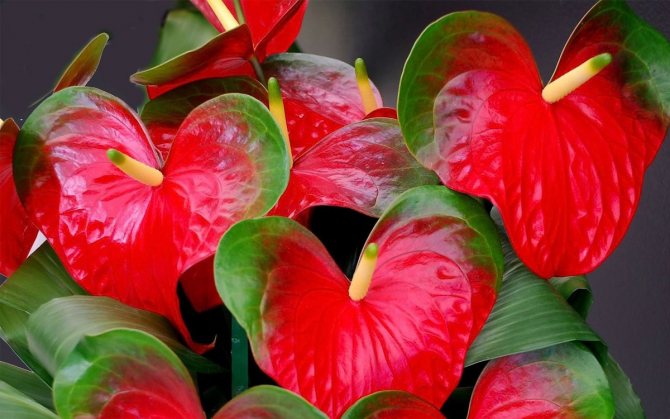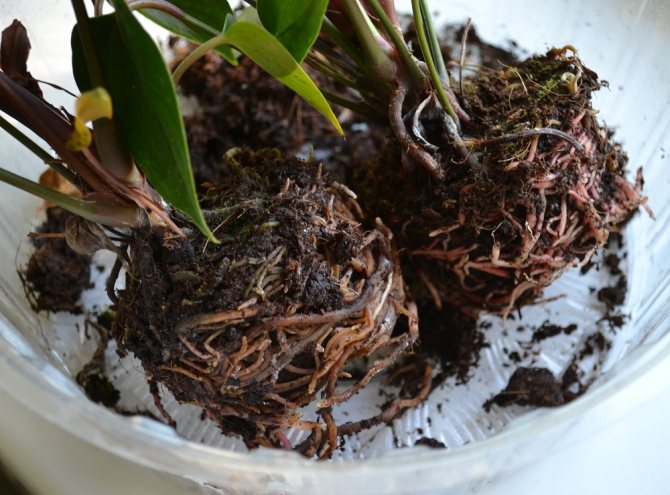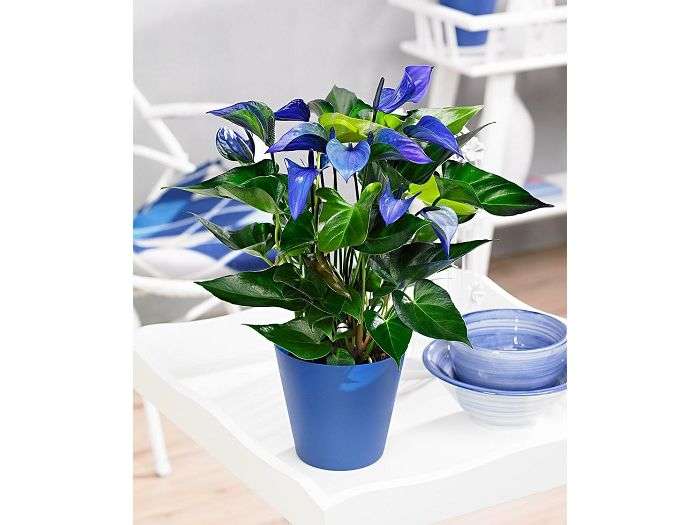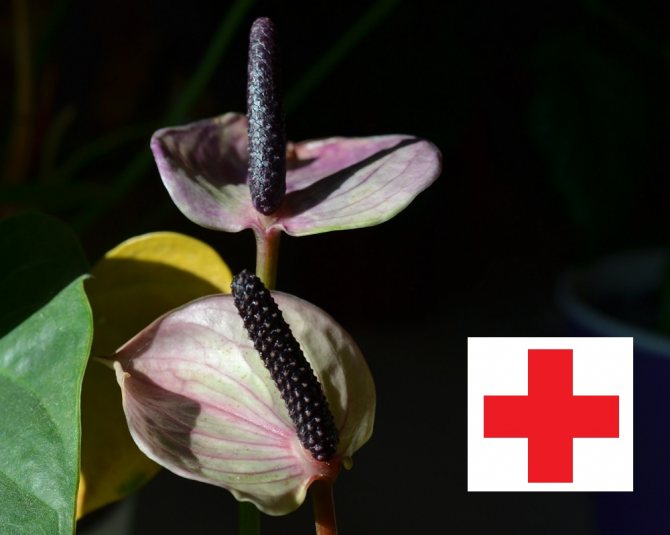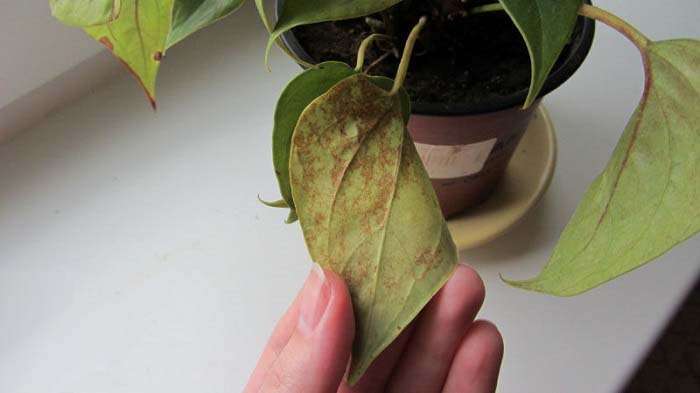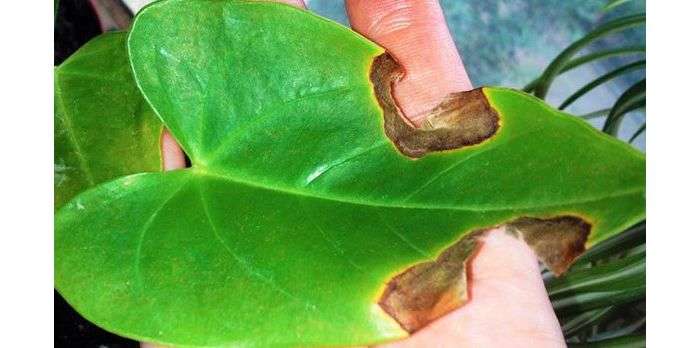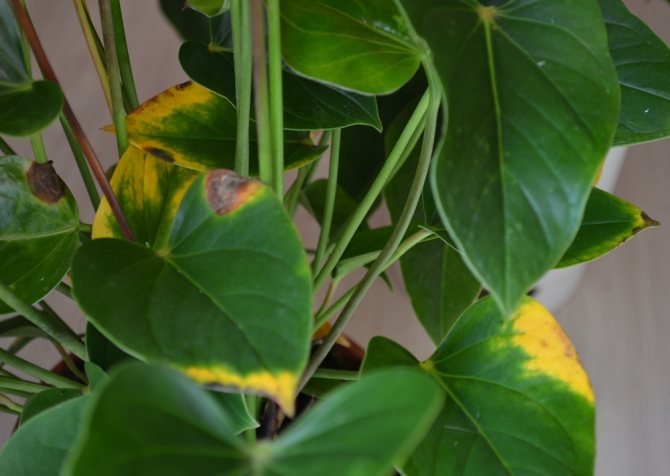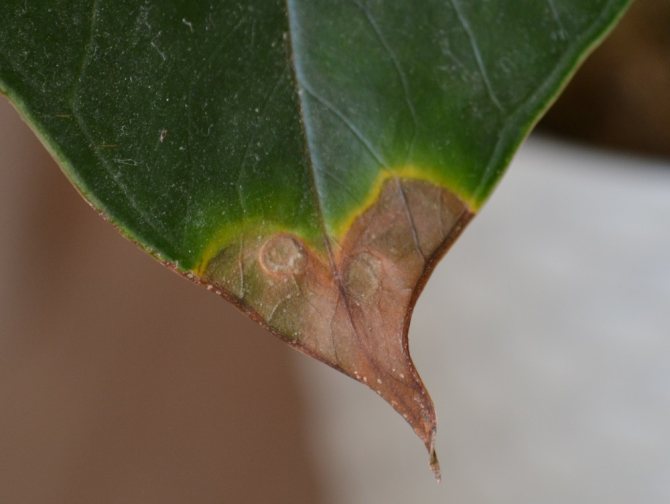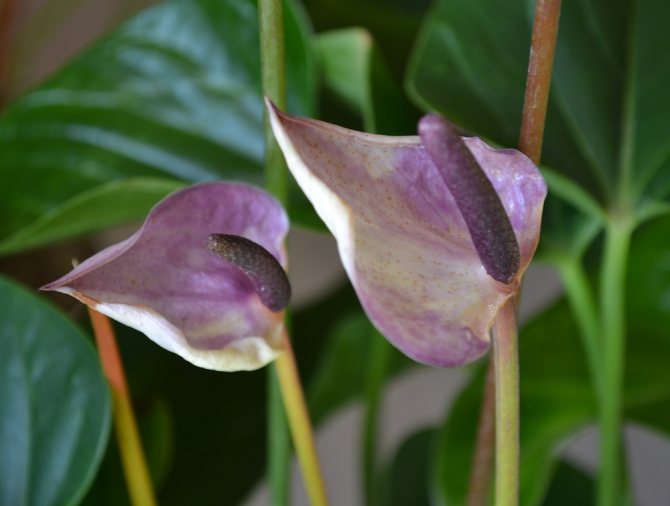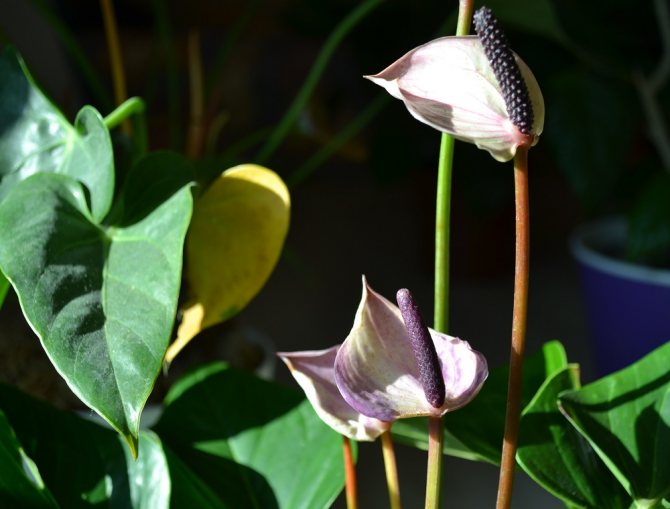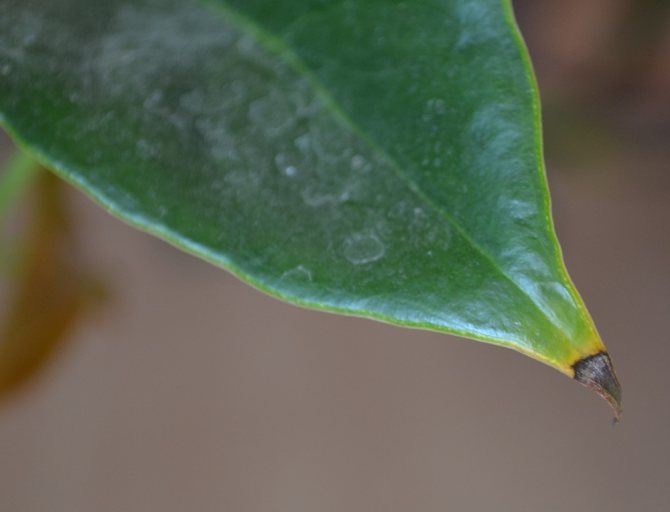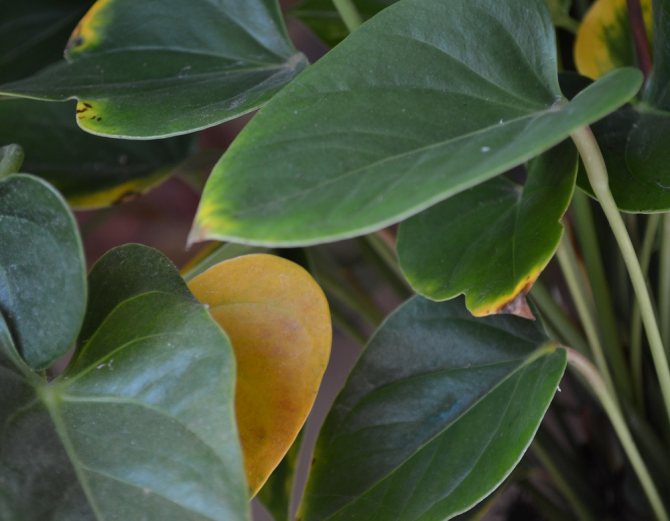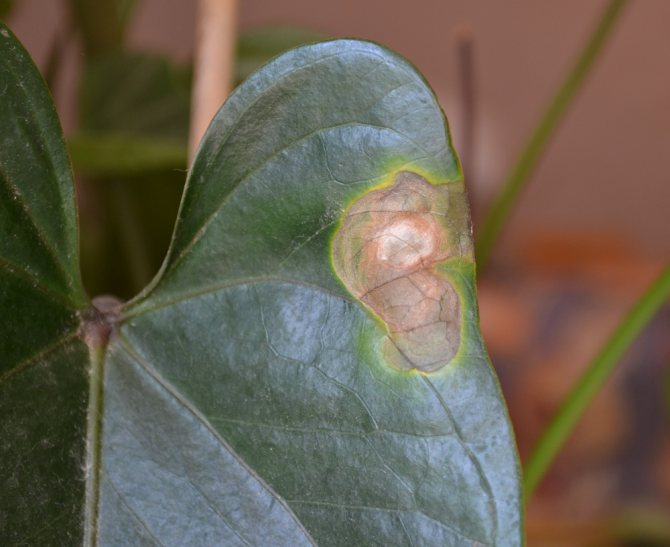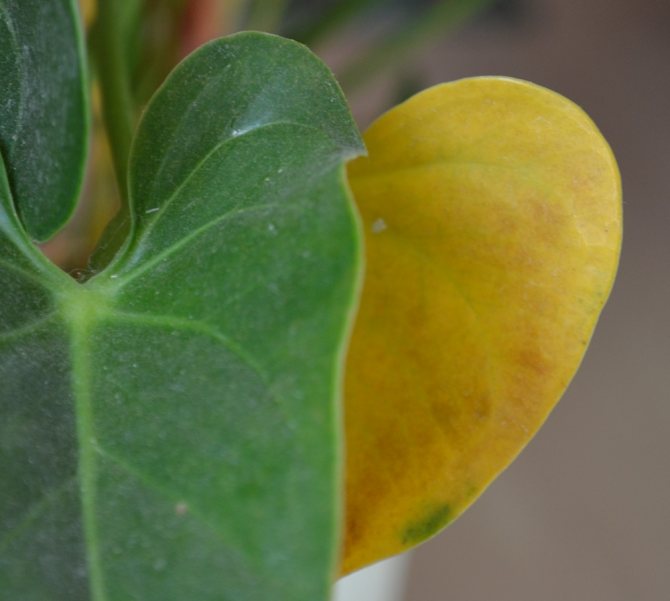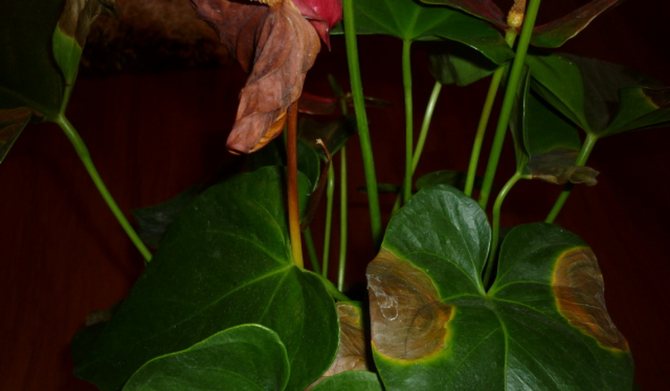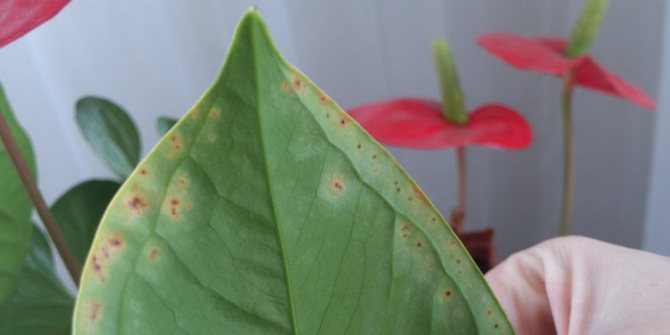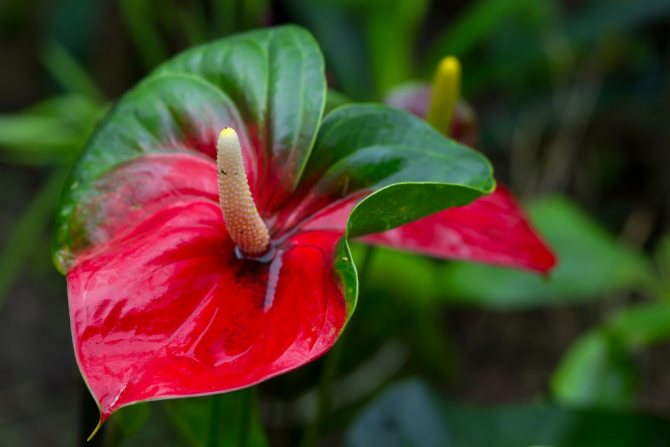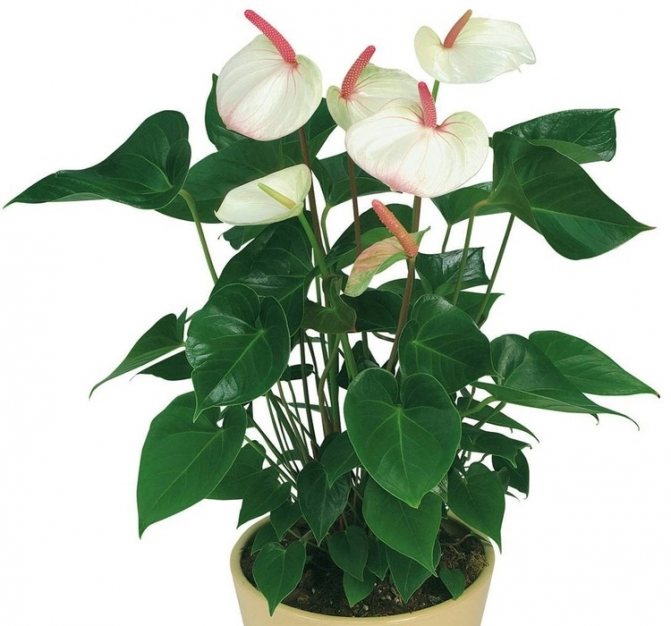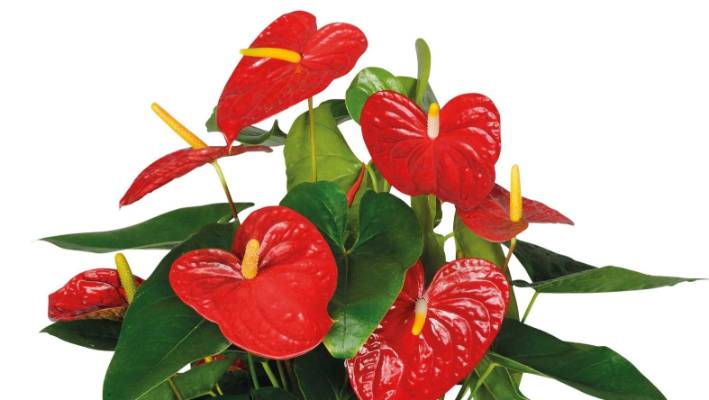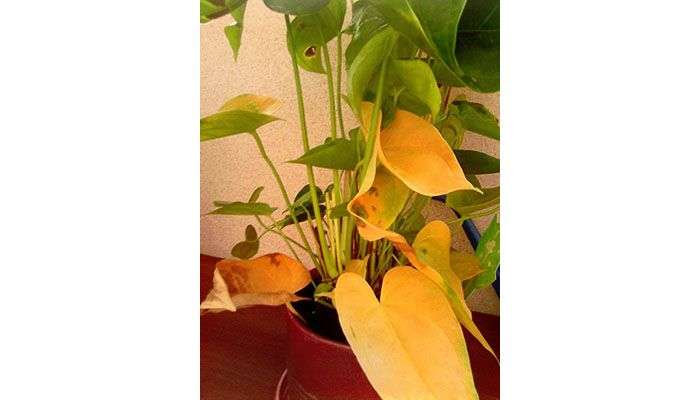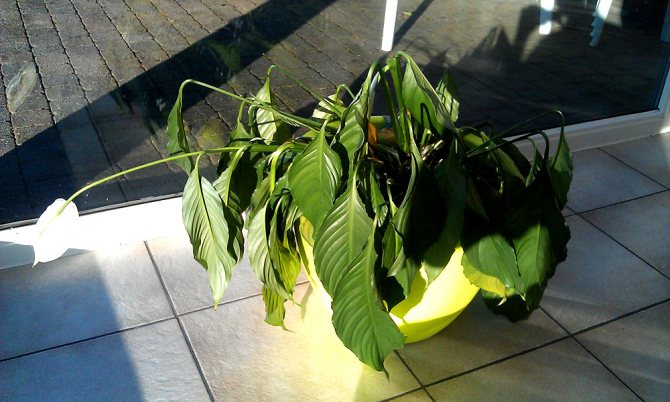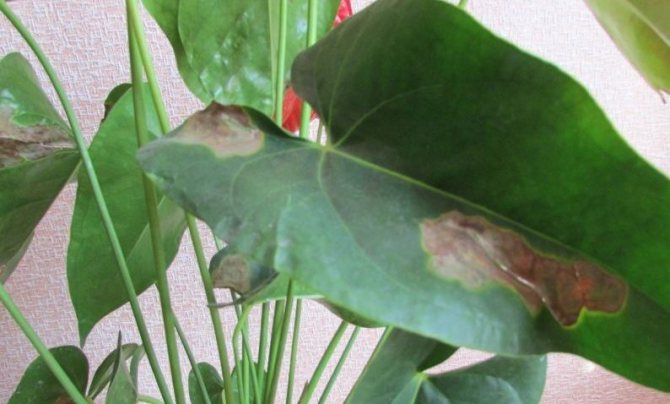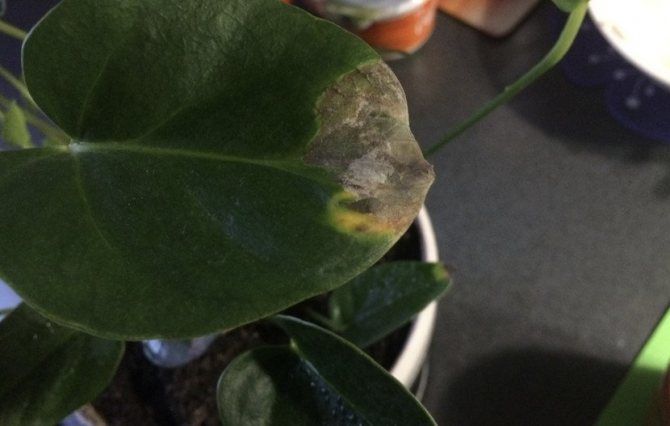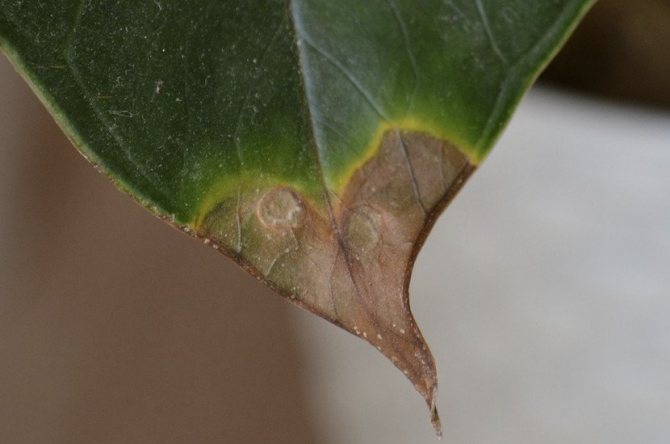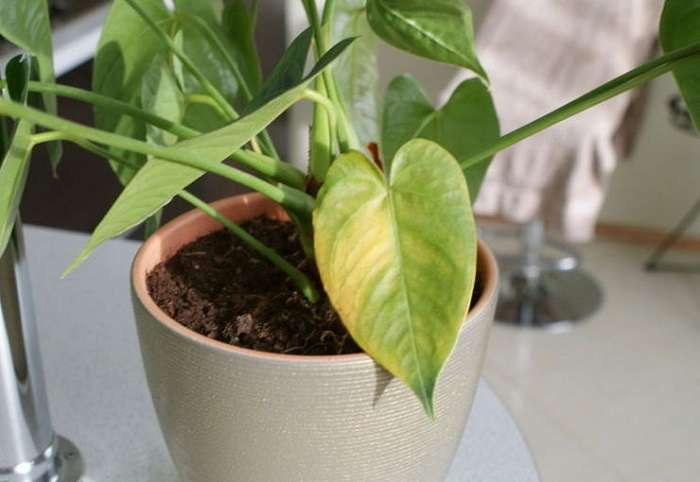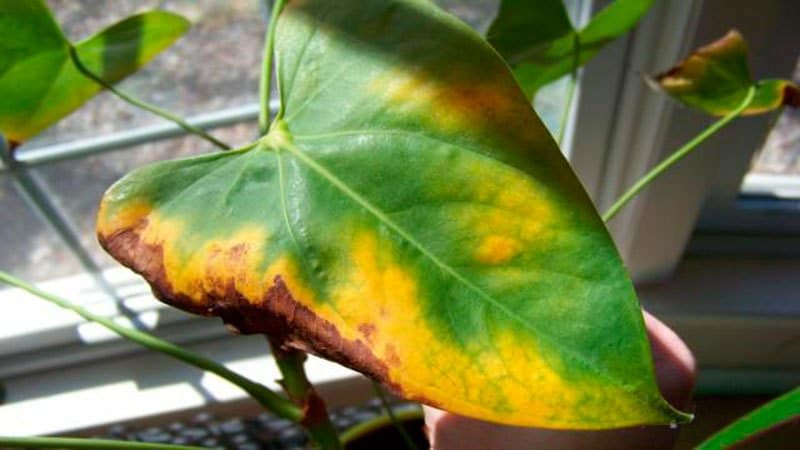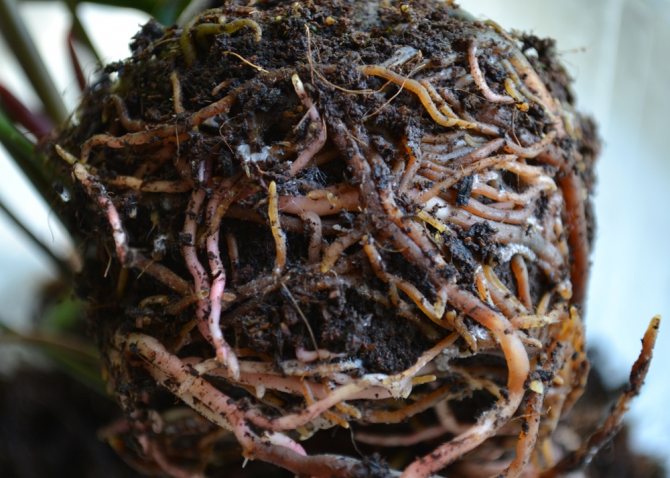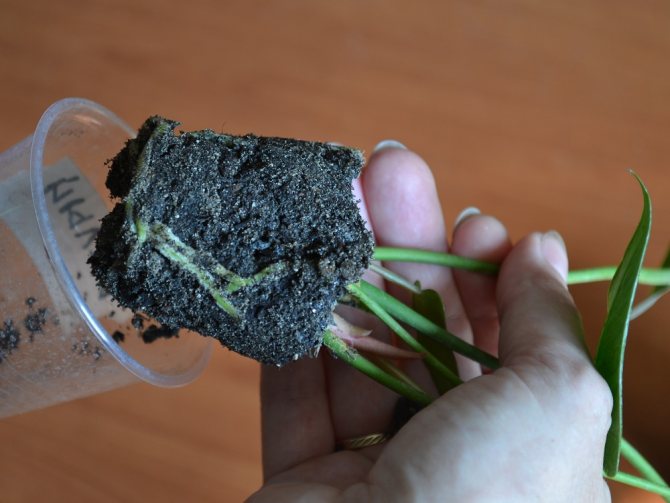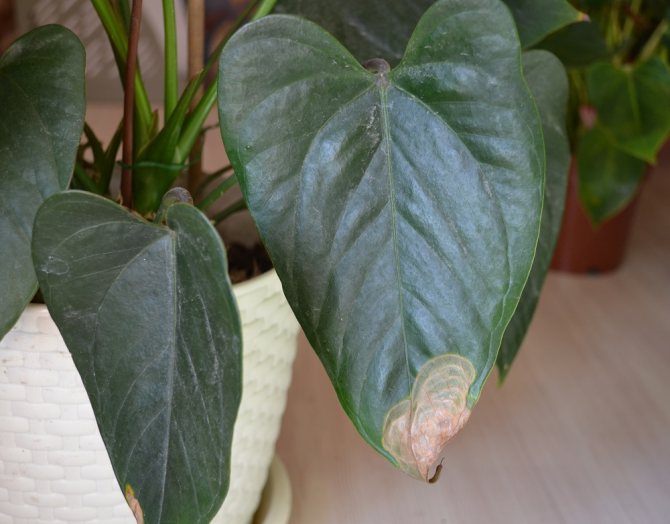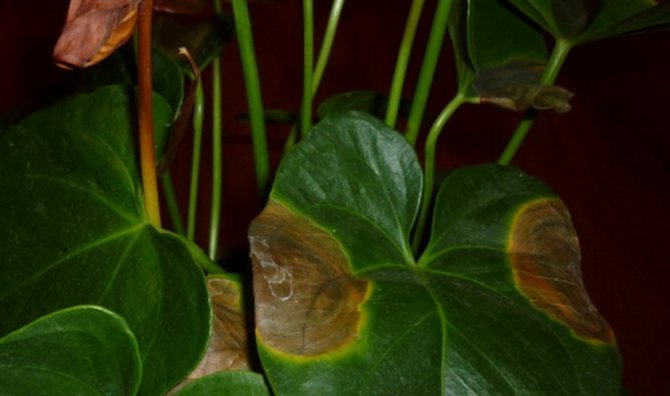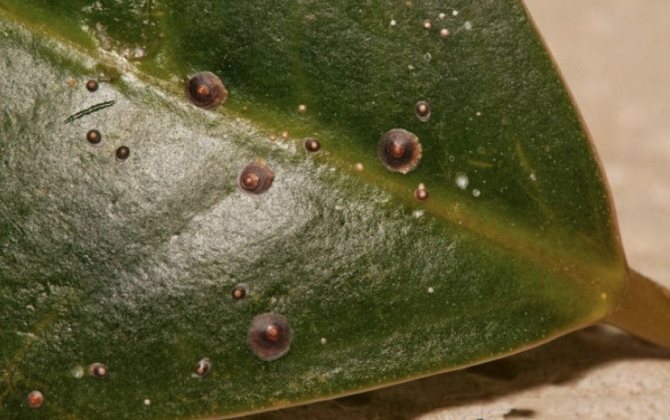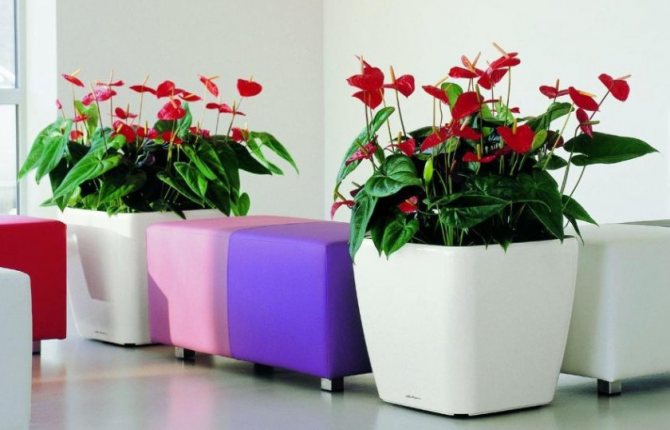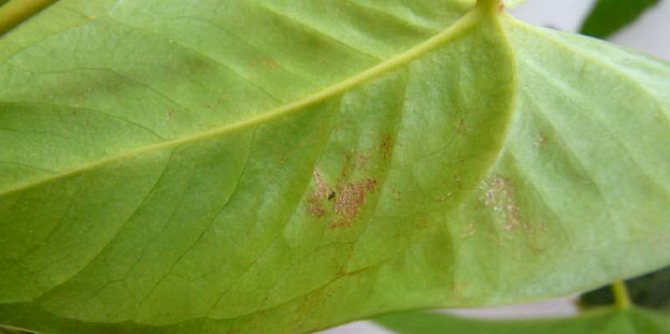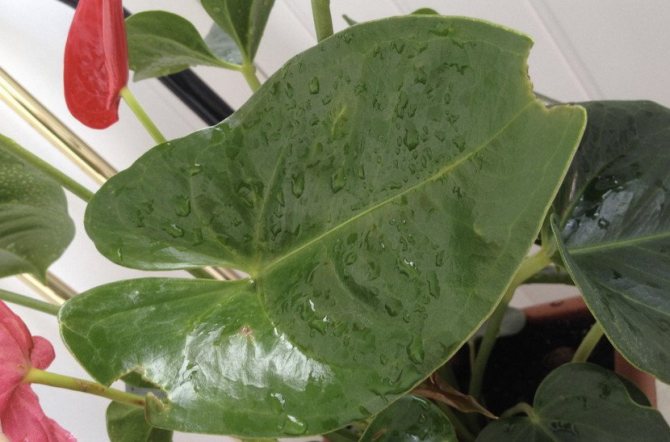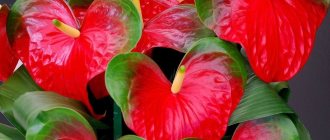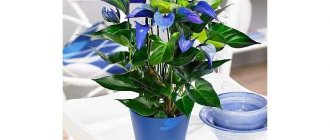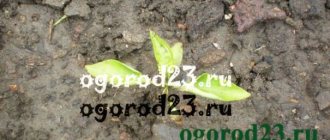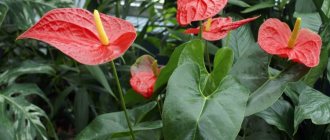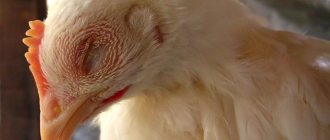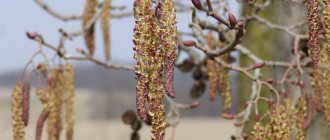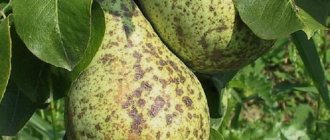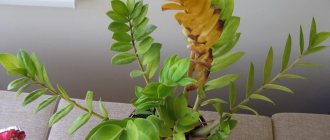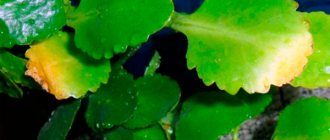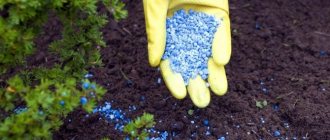Anthurium is considered the flower of kings. It blooms for a very long time, and at any time it pleases with its flowering. The plant blooms well and profusely when not susceptible to even the slightest disease. Therefore, everyone who wants Anthurium to please the eye and bloom all year round, must first of all study all the diseases of this flower. Anthurium is called "male happiness". Why a plant can get sick and how to treat it will be described in this article.
The plant is very thermophilic and very sensitive to watering, feeding and other care. If you shy away from the proper care necessary for this particular flower, then Anthurium will get sick in the near future. A photo of the plant is given in the article.
Causes of the disease and methods of treatment
Diseases of anthurium can occur even with the slightest violation of the conditions of its detention. After all, the homeland of "male happiness" is located in southern countries, so not every climate will suit him, besides, a cramped pot, a lack of light also add a fair amount of discomfort to a capricious flower. In order to avoid serious consequences, it is important on time and most importantly to correctly determine the causes of his unusual condition.
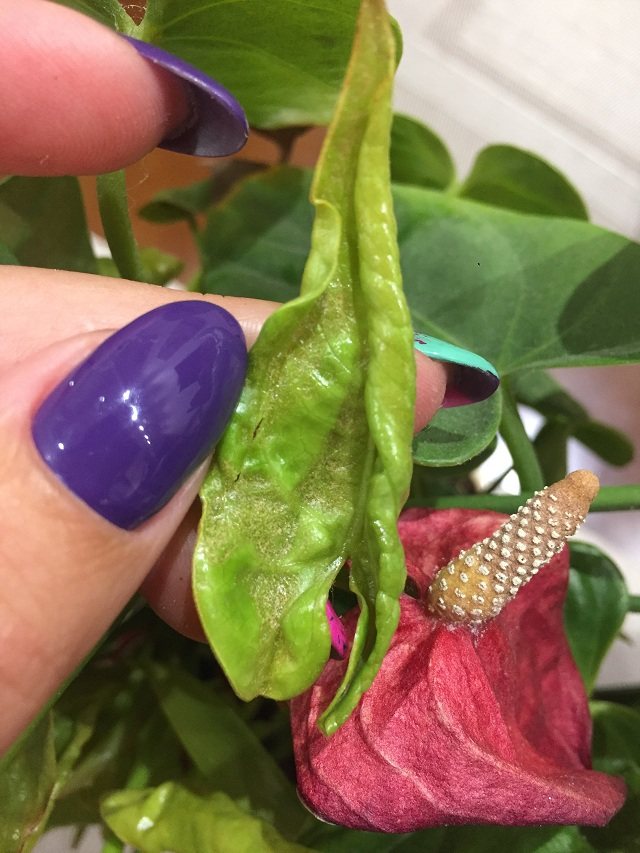
Anthurium is susceptible to various diseases. For example, it is quite vulnerable to fungus, viruses, and various infections. Moreover, you should not waste time trying to cure it using folk methods - this will only aggravate the situation and lead to irreversible consequences. Lost time can also play a fatal role in this case. The following are examples of the most common flower diseases, as well as their home treatment.
- Anthurium anthracnose (copperhead) is a fungal disease that often affects legumes, berry bushes (gooseberries, currants, raspberries). Basically, the copperhead attacks weakened specimens that have mechanical damage. High humidity also contributes to its development. Spreads with rain and wind, affected by seeds. For treatment, fungicides are required (Redomil Gold, Cuproxat). Processing is carried out twice, with a break of 20 days.
- Septoria. It appears on the leaves in the form of uneven brown spots with light edges. When viewed under magnification, small dark specks of sporangia (reproductive organs of plants that perform the function of asexual reproduction) can be distinguished. In this case, you should urgently remove the infected leaves and reduce the humidity in the room. You can heal with preparations containing copper, as well as fertilizers for flowering plants. Do not spray the leaves with water until it is completely cured.
- Chlorosis. Non-infectious disease that can be identified by the presence of pale yellow spots on the leaves of anthurium. The reason is iron and magnesium deficiency. This ailment can be easily eliminated with the help of regular fertilizing with fertilizers for decorative flowers.
- Thrips (vesiculate). These are insect pests that can parasitize almost any plant. The affected plant loses its foliage and withers. Visually, the accumulation of pests looks like a gray bloom, also consisting of their larvae and secretions. First of all, the diseased plant should be isolated, and the surface on which it was located should be treated with detergents.Then wash the plant with a sponge dipped in a solution of laundry soap and process according to the instructions with one of the following preparations: Karate, Aktelik, Intavir.
In order for the anthurium to be healthy and delight home and guests with its beauty, it is important to comply with preventive measures for possible diseases. For example, regular moderate watering, timely airing and the necessary level of humidity in the room will avoid a lot of health problems for this green handsome man.
Lack of inflorescences
Anthurium at home begins to flower only when it reaches the age of three. If this did not happen, then, for some reason, the growth and development of the plant were disrupted. These include:
- various violations of the temperature regime in the room, drafts;
- irregular watering, quality and quantity of water;
- insufficient soil drainage;
- too low a temperature contributes to the fact that anthurium can hibernate and stop growing;
- insufficient moisture level;
- bad light;
- too large capacity.
Flowering can be stimulated with periodic fertilization with phosphorus, and the soil can be washed monthly in running water. This is quite simple to do - you should put a container with anthurium in the bath and turn on the shower. Observing all the conditions for the comfortable state of the plant, you will get a healthy luxurious flower that will decorate any room.
Anthurium flower transplant and home care. Anthurium transplant
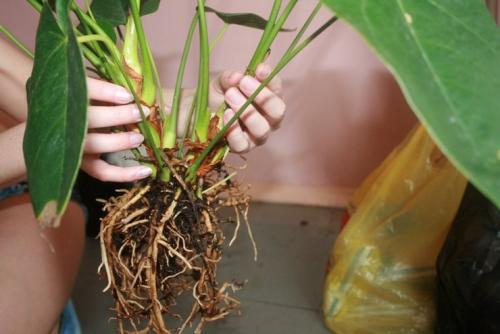

Anthurium has about eight hundred different species in its friendly family, which are not inferior to each other in extraordinary beauty and high decorativeness. The main features of this culture are white, pink, greenish, red and orange flowers, as well as light or dark green leaves. Many have the opinion that anthurium belongs to capricious cultures. In fact, with all the necessary growing conditions, you can enjoy unique flowering throughout the twelve months. The main thing is to follow several important rules:
- Maintain high humidity in the room;
- Protect the plant from drafts;
- Observe the temperature requirements of the flower;
- Timely (once every 3 years) to carry out a transplant.
When to transplant anthurium
It is better to replant the grown plant in the warm season - in spring or summer. An exception is a purchased plant. It is recommended to transplant it immediately after purchase, preferably within the next 3-4 days. This is necessary to inspect the condition of the root system of the anthurium, as well as to transfer it to a more suitable flower pot.
Important reasons for transplanting a houseplant are:
- The root part has grown so that the soil is not visible in the pot, and roots peep out of the drainage holes;
- A white (or rusty) coating appeared on the surface of the substrate in a pot with anthurium, which indicates depleted soil.
It is recommended to replant young crops under the age of four and replace the soil mixture once a year. Houseplants older in age undergo this procedure less often - once every 3 years.
Anthurium transplant at home
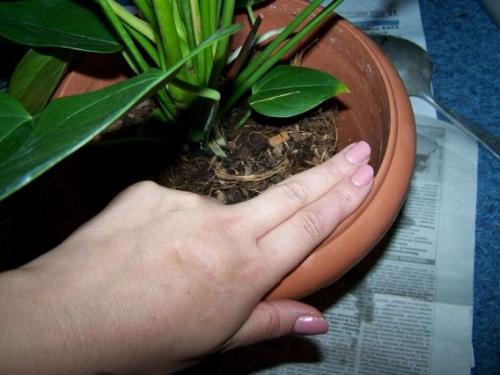

Choosing a flower container
Anthurium prefers free space, so the pot must be deep and wide. The material from which the pot is made can be different. For example, glass, plastic, natural clay. When buying a clay pot, it is recommended to purchase a vessel glazed on both sides, since the roots of anthurium can grow into clay without glaze.
Land for transplant
Experienced florists recommend taking one of the proposed soil mixture options for growing anthurium:
- Soil substrate for planting and growing orchids. Its composition: sphagnum moss, expanded clay, charcoal, crushed tree bark.
- A soil mixture from forest and sod land, as well as marsh moss.
- The substrate for epiphytes, to which anthurium belongs, consists of leafy soil, coniferous soil, peat (one part of each component), coarse river sand (half a part) and a small amount of charcoal and crushed bark of coniferous trees.
Anthurium transplant after purchase
First, you need to prepare a new flower container for transplanting, pouring about a quarter of the volume of the drainage layer into it. Anthurium, before removing from the old pot, must be watered abundantly, then it will be pulled out of the container more easily and without damage. Holding on to the lower part, the plant is carefully removed from the pot and the condition of the root part is carefully examined. If necessary, the damaged or unhealthy parts of the roots are removed, after which they are treated with any disinfecting agent (for example, "Fitolavin"). After processing, the anthurium is placed in a new pot and the substrate is carefully poured around the flower, lightly tamping the soil. It is recommended to fill the flower container, not reaching its edge 2-3 centimeters. In this way, a purchased plant is transplanted.
A transplant for the purpose of replacing the soil is carried out in the same way, only it is important to remove all the old soil from the root part. It will easily move away if the roots are briefly lowered into the water with the earth.
Transplanting anthurium during flowering
Usually, flower growers do not recommend replanting plants during the flowering period due to possible stress and shedding of flowers, but this recommendation does not apply to anthurium. Blooming anthurium can be transplanted without negative consequences for it. In the process of transplanting, the most important thing is not to harm the integrity of the root part of the flower, since they have a fragile structure.
Division of anthurium during transplantation
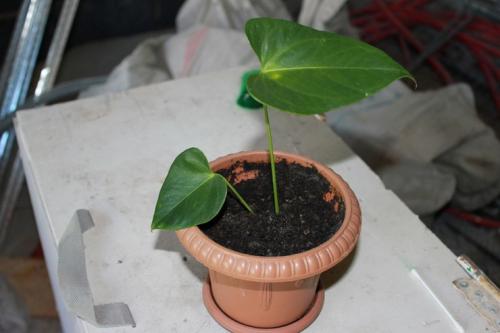

During transplantation, you can take the opportunity and divide the bush for further reproduction. Indoor cultures over the age of 3 years are suitable for this procedure. The most favorable time for breeding is January-February. During these months, anthurium leaves are shed.
The plant must be removed from an old flower pot and carefully divided into several parts. The root part can be cut with a knife. Each division should have approximately the same number of leaves and growth buds. Places of cuts on the roots should be sprinkled with charcoal powder, after which they are immediately planted in small pots with a drainage layer. After the substrate is compacted in the pot, the delenki are watered.
Anthurium care after transplant
It is necessary to water the culture in the first 2-3 weeks in minimal volumes so that the roots have time to get stronger and not rot. It is not recommended to apply fertilizers in the next 15-20 days. The place where the anthurium is grown should not be in direct sunlight. Spraying should be done regularly once a day. The temperature in the room with anthurium is 20-22 degrees Celsius. Tall plants will need a support tie.
Why do anthurium leaves begin to dry
Such a handsome man as anthurium can also be exposed to various types of diseases. Leaf disease is the most common ailment for this plant species. In this case, you should eliminate the cause as early as possible in order to preserve its glossy foliage. Leaves can dry out for the following reason:
Young leaves slow down in growth and dry out. In order to eliminate this problem, it is enough to make a plant transplant, since in this case, there is a high probability of problems of the root system. To eliminate it, you should remove the plant from the flowerpot and remove the rotten roots. Then dry the roots for an hour and place the flower in a new pot with thoroughly loosened soil.After a short period of time, you can see how the plant comes to life, releasing new leaves. If necessary, it is allowed to independently stimulate its growth with the help of the preparations "Ovary" or "Bud", which can be purchased at any suburban store.
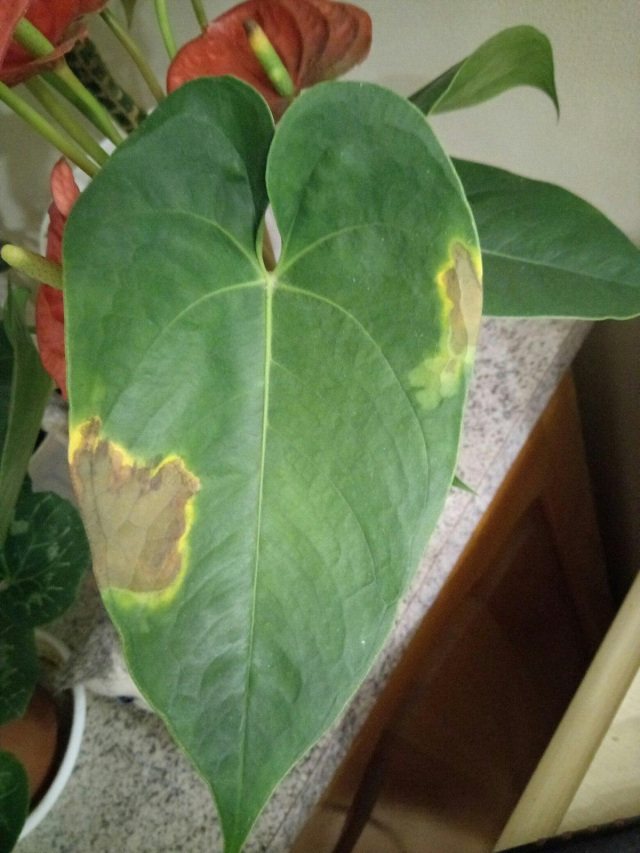

If you noticed that, along with the leaves, the trunk also dries, this indicates that the soil in which the plant is located contains a large amount of salt. Therefore, in this case, only a transplant will help, since there is a great threat of plant death. In the future, the soil should be selected taking into account the balanced composition.
What does anthurium look like: photo
In the photo in our gallery you can see what this flower looks like. He's very handsome, belongs to evergreens... Anthurium comes from the tropics, and its flowers have a special bizarre shape, which is why it is often called the flamingo flower.
Anthurium is very popular among amateur and professional flower growers. It looks unusual in itself, and it can also be used in different ways in different flower arrangements and bouquets. If you wish, you can find a photo of examples of such combinations.
Another feature of the plant is the ability to stand cut in a vase for several weeks in a row.
However, there are a number of anthurium diseases that affect the leaves of the plant. They give owners a lot of trouble. Most growers believe that they are better prevented than treated.
Why does green mass turn yellow
Yellow spots on the leaves of anthurium are mainly of concern to novice growers, since with the acquisition of experience, these errors practically do not arise. The most common reasons for their appearance:
- Violation of the watering regime. Do not forget that anthurium requires a different amount of watering depending on the season. Violation of the regime can lead to the appearance of this type of stains.
- Incorrectly selected water for irrigation. Anthurium is a rather capricious plant that requires a certain temperature of water for irrigation, as well as a certain composition of it. Too cold or hot water can cause this disease. Unsettled tap water, which contains chlorine and lime, also has a detrimental effect on the condition of the plant.
- Deficiency of essential minerals. The appearance of spots on male happiness may indicate insufficient feeding and fertilization of the plant. These formations are also called drop chlorosis, they arise with an excess or deficiency of manganese. If the problem is not resolved in time, the leaves begin to wrinkle and fall off. For treatment, treatment with bactericidal preparations is required, which can also be used for preventive measures. You can also use a weak solution of potassium permanganate for watering, but not more than once a month.
- Sunburn. This type of formation can appear from direct sunlight if the plant is in the sun itself. The leaf plates get burned in the form of a large light formation. Over time, it turns dark brown or black. The affected leaves can no longer be cured, so they should be removed. To preserve the plant, the flowerpot should be moved to a more suitable room, in which there is no threat of burns. For example, to the window on the east side of the house.
- Decay of roots. This problem is most common among anthurium diseases. It is characterized by the appearance of leaves with a yellow-brown border, as well as dark formations. From the very beginning, the affected areas spread rapidly throughout the entire leaf mass, so measures should be taken as early as possible.
If most of the foliage is preserved, the flower should be treated with copper oxychloride (0.5%), removing the affected leaves in the process.
Insect pests
Not a single flower is immune from damage to a flower by various pests. Even the one in the cultivation of which all agrotechnical rules are observed. Parasites can infect the flower stalk itself The flower stalk is the upper part of the stem on which the inflorescence grows. In the initial stages of development in orchids, it is difficult to distinguish the peduncle from the root. Here are some of the differences: •… More, leaf, stems and roots. Anthurium is quite resistant to insect pests. Nevertheless, sometimes he can become their victim. Such attacks weaken the vitality of the plant, sucking the juices out of it. Who infects anthurium and how to deal with insect pests:
- Aphid - feeds on the juice from the anthurium, sucking it out. The affected bush withers, the leaves curl and a sticky bloom appears on them. If the grower noticed the pest at an early stage, it will be enough to bathe the anthurium under a warm shower with laundry soap. If the flower is severely affected, insecticide treatment is necessary. Aktara, Antitlin will do.
- Thrips - settle on the back of the leaves, leaving black dots behind them. Yellow spots of various sizes appear on the bush. Thrips can appear at any time of the year, but the spring-summer period is the peak of their development. A sick anthurium is sprayed with insecticides. For example, Tantrek, Akttelikt. The processing procedure must be repeated every three to four days, until the insects disappear completely.
- Scabbard - at the initial stage of the appearance of this pest, it is not visible. This makes it much more difficult to deal with it. The shields are glued to the sheet. They need to be removed mechanically. That is, with a cotton swab or a needle. Scabbards have a very dense shell, so treatment with chemical insecticides does not give the desired result. Oil solutions and kerosene can help remove the shield. After them, you need to wash the anthurium with a solution of laundry soap.
- Spider mite - when it is affected by anthurium. Small yellow spots appear on it. The spots spread quickly and the leaf withers. It is impossible to see the tick with the naked eye. But the cobweb is visible. She wraps the leaf, stems and flower. From what they curl and fade. On the affected anthurium, you need to remove the cobweb. Then the flower, pot and the nearest surface are washed out with soapy water. With a strong infection of the plant, it is necessary to treat it with insecticides. If the plant is not properly cared for, the spider mite may return.
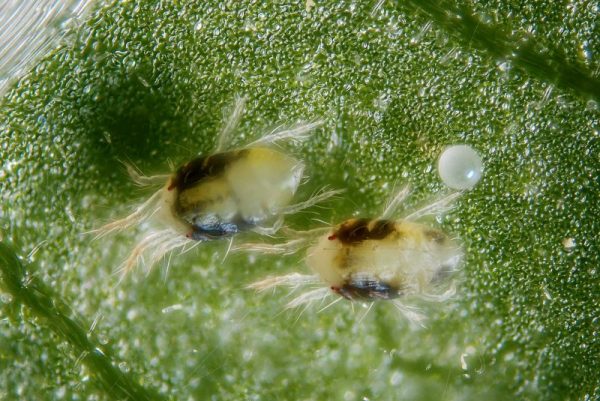

Do not forget that for the period of treatment it is necessary to isolate the diseased anthurium bush from other indoor flowers.
In the treatment and prevention of diseases in indoor flowers, it is advisable to use biofungicides. They are safe for humans and animals. Still, anthurium disease is better to prevent than to cure. Observe the cultivation technique, regularly inspect the flower for the presence of fungi and pests, pay attention to any changes in the change in the saturation of the color of the leaves. In a healthy anthurium, they are dense, bright green. Preventive measures should preferably be taken 1-2 times a month. So you will protect your plants from diseases, and yourself from unnecessary trouble and get beautiful flowering plants breathing life and beauty.
Drying of deciduous mass
Lethargy and dry foliage are signs of disease manifestation. Sick (these symptoms are quite dangerous) plants in the same room with healthy ones should not be. The first step is to isolate the affected flower to avoid massive contamination of indoor vegetation.
Outwardly spectacular anthurium is able to make it clear that the care for it is not carried out well enough. One of these symptoms is complete desiccation of the leaves. First of all, a lack of moisture leads to this state.Since anthurium comes from the humid and hot tropics, it requires a sufficient amount of moisture in the room for a comfortable existence.
Since the leaf plate of the flower is quite wide, it quickly loses moisture, especially when exposed to air flow. A draft dries up the leaves of a flower most quickly. In order for the plant to return to normal, the temperature and humidity level in the room should be adjusted, which can be measured using a hygrometer. Also, the plant should avoid drafts, but the room should always be well ventilated.
Darkening of green mass in anthurium
The acquisition of a dark shade and drying of the leaves of anthuriums indicates the presence of a soil fungus. Several of its species form entire colonies that lead a parasitic lifestyle. The initial external sign is darkening on the leaves, black spots acquire color later. The foliage soon dries quickly and falls off. On the root surface, as well as on the lower part of the stem, you can find dark spots with a dense bloom of white.
It is this plaque that is the formative element for the dispute. At the same time, even with the naked eye, you can see small black dots that carry disease and infect other plants. The affected stem is slightly watery to the touch. Subsequently, a dense gray mold appears on the surface of the leaves and inflorescences. Young plants are most vulnerable to fungal infection, as well as flowers transplanted into a new container with fresh soil.
The fungus, multiplying in the soil, penetrates the root system of the plant. Infection is facilitated by poor-quality soil, insufficiently disinfected container for planting. Excessive watering, in the absence of sufficient drainage, as well as insufficient ventilation of the room, are also the causes of the disease. To treat a flower, remove it from the pot and place it in disinfected soil, in a new planting container. Remove all affected areas of roots and foliage. Rinse the roots in a solution of potassium permanganate.
Groups of diseases of anthurium
Diseases of indoor plants are divided into 2 groups: non-infectious and infectious.
Non-communicable diseases are the result of a violation of the content of a flower in conditions that do not meet its requirements. Such diseases do not affect other plants. When the source of the disease is removed, they recover without harming other crops.
Infectious diseases cause pathogenic infections that necessarily affect other plants. Changing hosts, pathogenic fungi, bacteria and viruses multiply rapidly and in a short time can destroy almost all nearby plants.
Drying of the tips of the leaves of anthurium
If the anthurium is sick, its foliage is also sick. Dry leaf tips can occur for a number of factors. For example, a lack of sunlight may be the culprit. Most likely, the pot with the plant is not in a sacred enough place, so it is better to move it. However, do not forget that in the sun, under direct rays, the plant can get burned and even die.
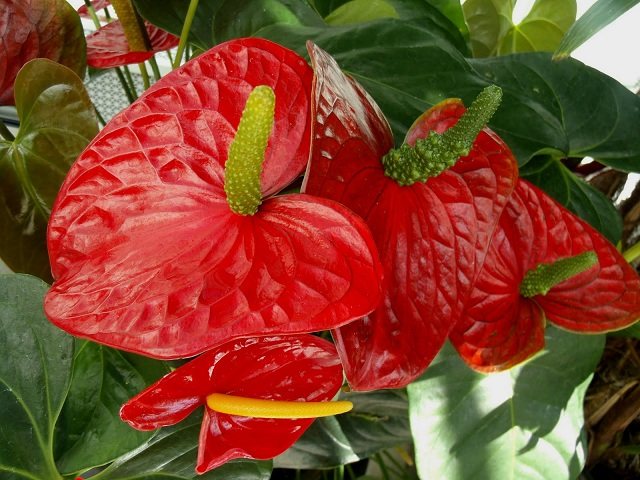

Another cause can be infestation by pests such as greenhouse aphids. The most common and simplest way to eliminate the problem is treatment with Karbofos.
If the dried tips of the leaves are accompanied by the growth of brown spots. This may indicate that the plant is freezing. Check the room temperature, it should not be lower than 22 ° C. If necessary, move the flowerpot to a different, warmer area and reduce the number of waterings. If after two or three days the flower has not returned to normal, a mealy worm may be damaged, in this case, the plant should be treated with Karbofos.
The appearance of brown spots on the leaves of anthurium
Brown spots have appeared on the leaves of anthurium, an urgent need to search for the cause of these changes. Brown spots may appear in the following cases:
Lack of nutrients is also characterized by yellowness and subsequent deformation of the spots, especially with nitrogen deficiency. Young shoots and lower leaves grow dull and weak. With a sulfur deficiency, the upper leaves suffer, and its excessive content in the soil contributes to the yellowing of the edges of the leaves, which eventually darken and curl. Manganese deficiency is characterized by small brown spots and wrinkling of the leaf plate.
Overflow and hypothermia can also contribute to the appearance of these formations; for this, the problem should be eliminated by reducing the amount of watering and moving the flowerpot to a warmer room. Also, these symptoms can appear as a result of diseases such as:
Fusarium, the causative agent of which is a fungus, and the infection occurs through the soil. The disease progresses from the roots, with subsequent damage to the leaves and stem. Often leads to the death of the plant. A fungicide is used for processing.
Septoria. Also caused by a fungus, however, the spots have a darker shade, lightened around the edges. To combat the pathogen, diseased leaves should be removed, and the plant should be treated with a fungicide, followed by a repeat after seven days.
Eliminating noncommunicable diseases
Non-infectious diseases include: violation of environmental requirements - draft, low temperature, dry air, improperly selected substrate, top dressing, watering, natural aging of the plant.
Problem: Leaves are curled throughout the plant.
The appearance of the leaves speaks of problems.
Cause and elimination of the problem:
Improper care for anthurium;
Environmental requirements violated. The plant is located in a draft. Not enough lighting or too bright burning lighting. Maybe the air is dry and watering is plentiful. When the requirements are normalized, the flower recovers.
Problem: Anthurium leaves began to turn yellow.
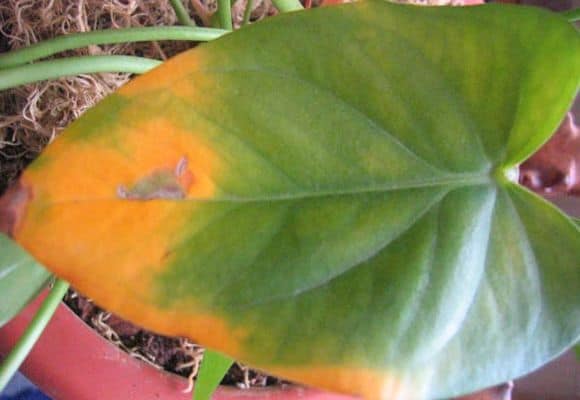

Leaves turn yellow
Cause and elimination of the problem
- If the lower leaves turn yellow gradually.
Natural aging of the plant manifests itself. It is enough to carefully cut off the old leaves with a disinfected tool. The plant needs rejuvenation. Yellowing of the leaves can cause disease.
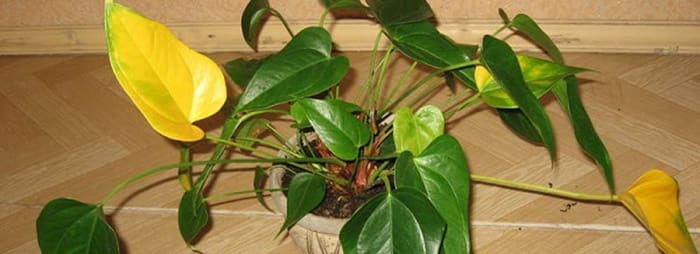

The second reason for yellowing of leaves is diseases: chlorosis, gray rot
- In a young plant, leaves turn yellow throughout the plant.
Possibly too bright lighting. It is enough to shade the plant or rearrange it to a less illuminated place.
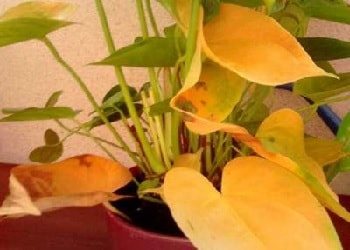

Yellowing of leaves in anthurium
- The green color fades, the leaves take on a yellowish tint.
Lack of lighting. Additional lighting is required in the autumn-winter period.
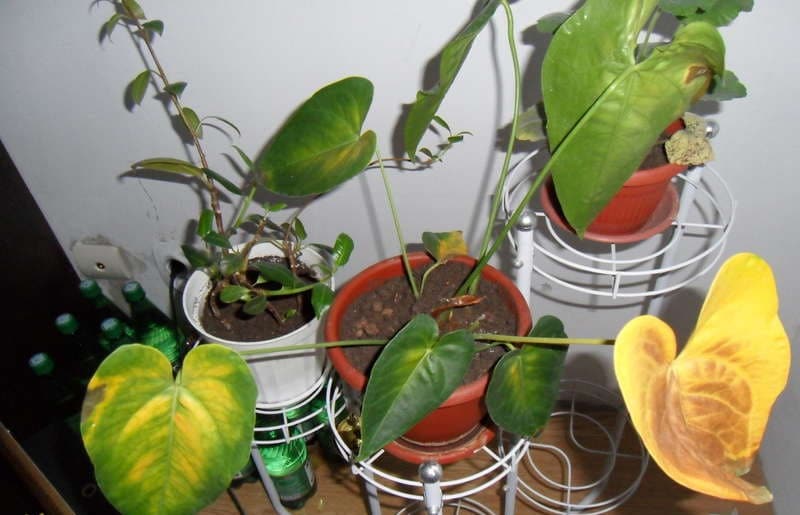

Plant leaves turn pale from lack of light
Problem: Anthurium leaves dry out
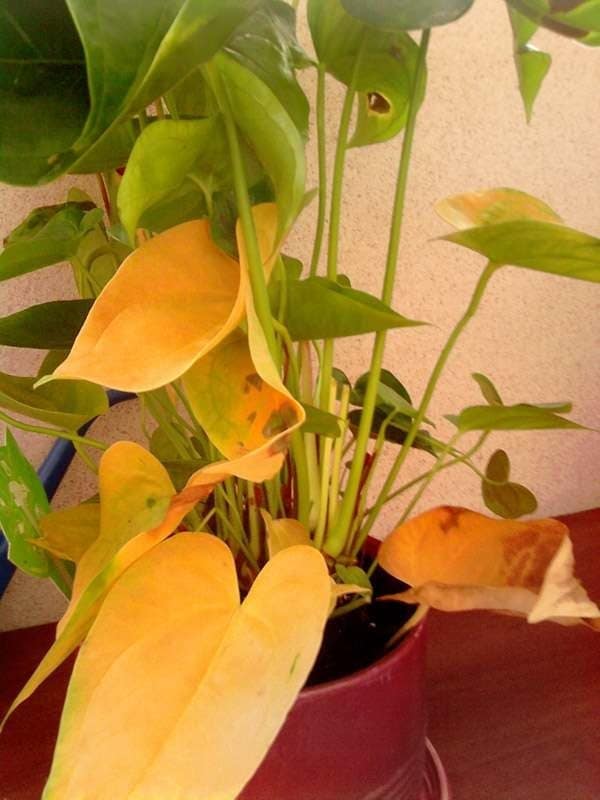

Anthurium leaves dry up
Cause and elimination of the problem
- Violation of temperature and humidity conditions.
- Possible cause is a draft. Move the plant to another place or eliminate the cause of the draft.
- There may be dry air in the room. It is necessary to install humidifiers, systematically humidify the air without moisture droplets falling on the flowers.
- Insufficient watering. If the soil is dry to the depth of the phalanx of the finger, watering is necessary. In the future, normalize the watering of the plant.
Problem: spots of different colors and diameters appeared on the leaves of anthurium.
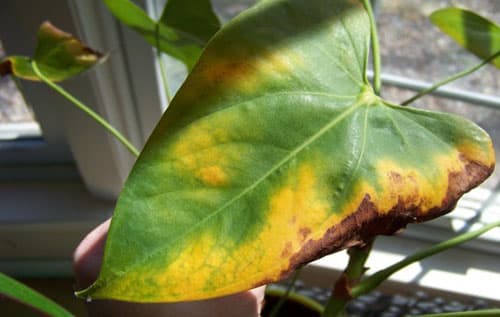

Brown, yellow spots. From an excess of light, the leaves of anthurium get burned.
Cause and elimination of the problem
- Sunburn evidence. Change of location or shading is required. It manifests itself in the form of brown spots randomly located on the leaf blades. Transfer to another place and create an optimal temperature regime.
Problem: Young leaves are too large with an unusual pale green color. The leaves take on a different color.
Cause and elimination of the problem
- An excess of fertilizers, especially nitrogen fertilizers.
- Violation of the amount and ratio of nutrients in the soil.
Additional watering is needed to flush out excess fertilizer. Adding agrovermiculite to the substrate. Reduce doses or temporarily exclude feeding. If the rules for feeding are not violated, a lack of trace elements is likely. Conduct feeding with a half dose of trace elements (buy in a store).
Problem: the tips of the leaves dry out throughout the plant, sometimes the leaf turns completely black.
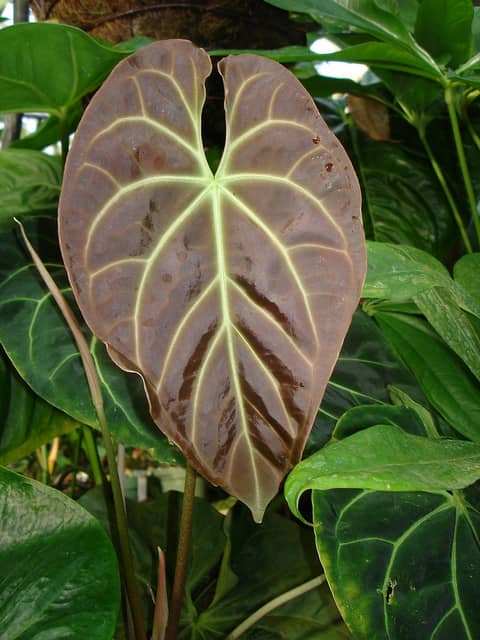

Cause and elimination of the problem
- Perhaps the humidity of the air and soil is greatly reduced;
- the roots do not have enough potting space;
- little oxygen enters the roots;
- the soil is excessively fertilized, contains an increased amount of calcium.
If the humidity is normalized, but the tips continue to dry, sometimes gradually capturing the entire leaf blade, it is necessary to transplant the anthurium into a new, properly prepared substrate, reduce the dose and reduce the amount of dressings.
Problem: the inflorescence dries and turns black.
Cause and elimination of the problem
- The natural flowering period ends;
- Too bright lighting, possible sunburn;
- Water got on the flowers when spraying;
- The humidity regime of the air and soil is violated.
Cut off diseased inflorescences with bracts. Shade the plant. Normalize the humidity regime. Keep expanded clay or pebbles constantly moist in the pallet. Exclude the ingress of water on the inflorescence and bedspread during spraying and watering.
Problem: Anthurium leaves lose their turgor, wither, but do not fall off.
Cause and elimination of the problem
- Too frequent and plentiful watering;
- Damage to the root system by fungal rot.
The plant must be urgently transplanted into another disinfected pot or other flower container. Completely change the soil. Rinse the roots in warm water with a weak solution of potassium permanganate. Trim diseased roots. Dry for 20-30 minutes. Treat with root and plant, observing all the rules.

